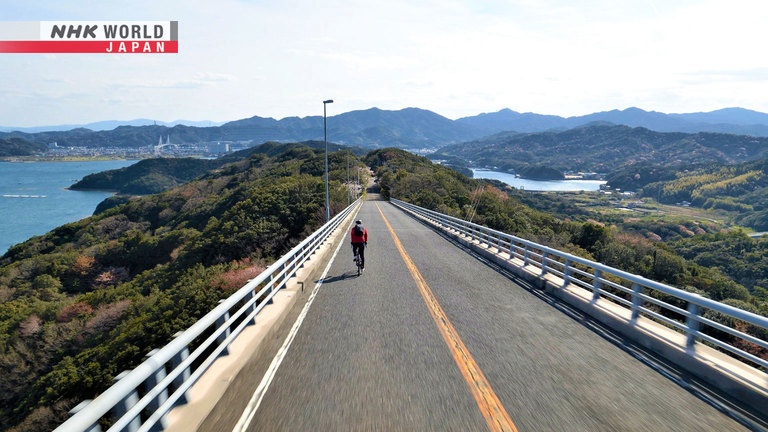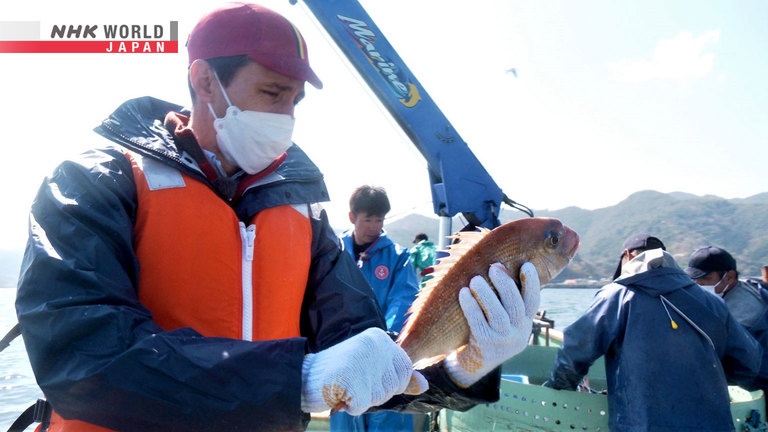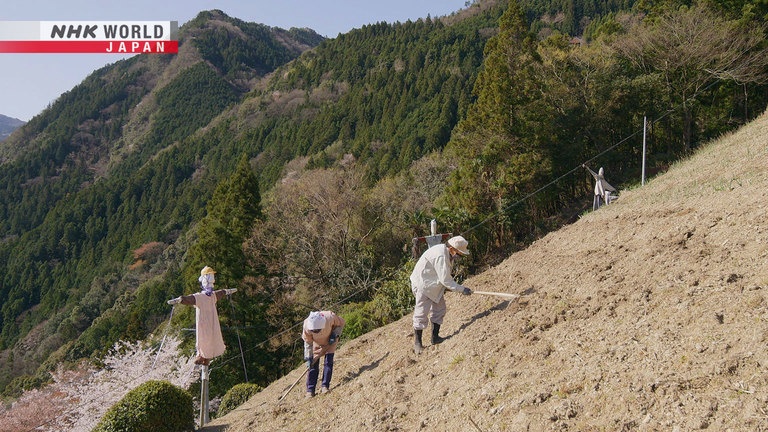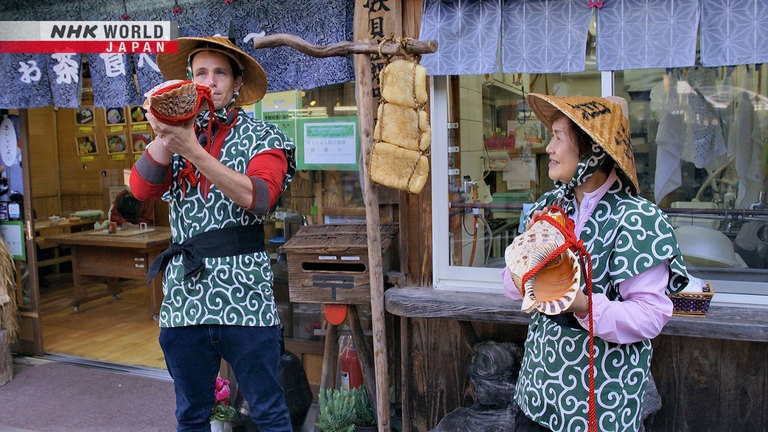Tokushima - Where Teamwork Runs Deep
As the cherry blossoms bloom in spring, our cyclist Bobby rides through Tokushima Prefecture from the coast to its hidden mountain valleys. At the Naruto Straits, famous for their whirlpools, he goes out with a team of fishermen to catch cherry sea bream. High in the mountains at Kamikatsu, he finds a town where the elderly population have a thriving business cultivating plants to decorate Japanese cuisine. And in an even deeper valley, he discovers a village with an unusual approach to attracting visitors.




Transcript
The best way to discover little-known sights and make even familiar places feel brand new, is to go exploring by bicycle.
In this episode, we'll explore Tokushima, with its beautiful coasts and lushly forested mountains.
It's April.
With spring in the air, the trees are at their most colorful...
...and the seafood at its tastiest.
Gorgeous color. Silver and pink.
This is like an animal trail!
When life is tough, it breeds cooperation and community.
I grew up surrounded by nature.
That's why I love it.
Tokushima's traditional arts also stress collective effort.
Come with us on a 350-kilometer ride through Tokushima, to discover what binds these people to each other and to their land.
Tokushima is part of Shikoku, one of Japan's four major islands.
It's a one hour and twenty minute flight from Tokyo.
Good morning.
We have arrived here in Tokushima, and it is an absolutely beautiful day.
Bobby Judo is American, born in Florida.
He came to Japan 16 years ago.
Bobby's two passions in life are cooking and bringing up his 7-year-old twin daughters.
All right.
This is the first time being in Tokushima in a long, long time.
It's got a great mix of coast and mountains to ride through, some easier rides some harder rides, and it's the perfect season.
And when we get out into some of the valleys in the mountains, we might even be able to get off road a little bit, which is why we're set up with these nice fat block tires.
Cycle Around Japan Tokushima trip.
Let's go.
On the first day, Bobby will cycle to the famous Naruto Straits.
On day two he'll leave the coast behind and start riding inland.
On the third day, he'll explore villages deep in the mountains.
And the final day will take him to the scenic highlands in the far west of Tokushima.
Clear blue skies, great sunny conditions with a really strong wind.
- Hello.
- Hello.
The road to the Naruto Strait takes us over several bridges between islands.
It's a picturesque route, extremely popular with cyclists.
What a great view.
Oh, that's nice.
Hello, ocean.
There's a reason this is such a must-see spot.
"Naruto no Uzushio," the whirlpool currents, in this area are really famous.
Oh wow, you can really see the pull of the tide in through there.
Twice a day, powerful currents passing through this strait cause spectacular tidal whirlpools, which can be up to 20 meters across.
The size of the whirlpools varies greatly with the season and the weather.
Bobby's come on a day when the sea is rather subdued.
The Uzushio currents bring with them the taste of spring, and Bobby is hungering to try the local specialties.
Oh, Wow.
That's fantastic.
Yeah!
One hour's ride from the Naruto Straits brings Bobby to the fishing port of Awata.
We're going to stop into this fishing port here.
One of the best things about these coastal routes is a lot of times you can find some really great seafood.
Hello.
- Matsushita san, the fisherman, right?
- That's me.
- I see you're about to set out?
- We're just about to go.
- What's in season now?
- We're just about to go.
Sea bream. But we call it cherry bream
because it turns pink in cherry season.
Matsushita Shuhei's family have been fishermen here for three generations.
All right.
All changed and ready to go out to sea.
Thanks for having me aboard.
I'll try not to get in your way.
They told me to stay put here.
They go out fishing when the tidal currents are at their weakest.
See all those buoys?
Our nets are hanging from them.
This is a traditional method of using fixed nets to trap migrating fish.
These Harimanada fishing grounds are famous for the vast numbers of fish funneled through here by the strong currents.
Keeping the fish fresh is paramount, so it's a race against time to pull the nets in.
It's so cool to see them work.
they've got eight people all working in unison.
Everybody doing their own part.
They're all pooling their strength together to bring up these huge nets and get all of this work done in such a short amount of time.
Thanks to these teamwork skills, the crew will haul in a very fine catch today - two whole tons of cherry bream.
May I?
Wow, look at this!
It's a beautiful fish, gorgeous color.
It's silver and pink.
These little light blue spots.
Super fresh.
Sea bream is at its best in spring.
At this time of year, bream store nutrients in their bodies as they get ready to spawn.
This turns them pink, hence the name cherry bream.
Bobby the gourmet can't wait to taste this freshly caught delicacy.
The fishermen lend him a knife and cutting board.
What a lovely color!
It's beautiful!
The color of this fish is gorgeous.
This got little pink hue to the meat close the skin on the top.
The rest of it is almost clear... It is translucent.
Delicious!
The fish itself is sweet.
It's got a really nice firmness.
Really, really rich oceany taste.
- You're lucky to be able to catch fish like this.
- Yes, I'm very grateful.
Born into a fishing family, Matsushita knew first hand what a harsh life it was, and wasn't attracted to the family trade.
When I was young, I hated the idea of being a fisherman.
All hard work and early mornings.
Also, since I loved sports, I dreamed
of becoming a professional athlete.
Deciding on a career in business, he went to study in China after high school.
Talking with fellow students from all over the world, he realized he knew nothing about his own homeland.
My classmates were from all over the world
and they often asked me about Japan.
It made me realize I knew
very little about my own country.
It also made me appreciate
the good things about my hometown.
I had to travel so far away to discover
how important it is to love your home.
Matsushita reconsidered, and at age 23 decided to become a fisherman after all.
His devotion to the sea has only deepened with time.
We are very lucky to be able to receive
the blessings of nature.
So we must always show respect to the fish.
Rough seas breed fine fish, and tough fishermen.
Riding south, Bobby has come to Tokushima's largest river, which crosses the prefecture from its source in the western mountains.
Huge broad stretch of river.
This is the Yoshino River.
It's a long bridge.
The bridge takes us across the river near its mouth to the city of Tokushima.
The city's origins lie in farming communities that prospered thanks to the fertile soil carried here by the Yoshino River.
Bobby has an objective in coming to this city.
All right.
Looks like we found our next stop.
We're headed right up here to this high school.
They're right in the middle of something inside.
What we're about to see is called "Awa Ningyo Joruri."
This is a traditional kind of puppet theater, accompanied by "shamisen" and "taiko" drums.
The themes are all about life in the samurai era.
It's been a popular Tokushima entertainment for over 300 years.
Here it's being practiced by the high school's 8-member performing folk arts club.
This is one of very few schools that offer "joruri" as an extracurricular activity.
- I hope I'm not interrupting.
- You're welcome!
Those are crazy high sandals.
I need to be this high up for the puppet.
- What's most fun about doing this?
- When a big audience really enjoy it.
Your puppet moves so naturally.
It's surreal.
It really feels like I'm seeing four people.
The club was set up in 1956, with the aim of helping to preserve this art, which was declining in the face of new forms of entertainment.
The school's specially built theater is now designated a national cultural asset.
The puppeteers work as a team of three.
Each is responsible for moving a different part of the puppet.
- How do you all work the puppet?
- I operate the head and the right arm.
- The head moves too?
- Yes, like this.
I do the left hand, using this lever.
That's how you make the wrist action look real.
- And what about you in the back?
- I hold it like this to move the legs.
Puppets are constructed just as they were over 200 years ago.
Some date back to the club's founding.
Oh wow, look at that!
All these heads.
So many different expressions.
Their eyebrows move too!
- And one really handsome guy too.
- Which one?
Wow. You can make him blink as well.
These girls learned all their puppetry skills after joining the club.
I do weight training to get stronger.
You work out with water bottles?
Even doing things like brushing my teeth.
So you're lifting weights all through the day.
Always imagining I'm holding the puppet.
What would you call your training system?
Oh, I don't know.
- Water bottle?
- Water bottle training. It could be a new diet fad.
The play they are practicing today is actually a prayer to the gods for a good harvest.
Good crops for the farmers,
good catches for the fishers.
The play is about the blessings of nature.
We should feel this as we perform.
These plays were always performed by the common people, so they reflect common themes and hopes.
Today's young performers are preserving one of their community's vital traditions.
That's just amazing to watch.
At times it moves so much like a real human being that you forget that there are people controlling it.
I'm in awe of all of the things that they can do.
Thank you very much.
A traditional art that exemplifies the very essence of teamwork.
Finally out, away from the coast, away from the city, getting into the countryside.
We are going to start heading up to the mountains.
Beautiful signs of spring.
Today, he's heading inland, up to the town of Kamikatsu.
Hey!
Wow. Great view through here.
Ah, gorgeous.
As the trail gets rougher, Bobby's grateful he had the foresight to fit thicker tires.
Oh, it's a super scenic spot up here.
Hello!
Oh, this is gorgeous.
Over 300 cherry trees line the banks of the Ikunatani River.
Bobby is now in Kamikatsu.
This town of just 1,300 people is famous for finding a unique solution to its aging and declining population.
This is it.
Here we are.
Hello!
- What are you doing?
- Picking camellia leaves.
- You're pruning to keep the garden tidy?
- No, I use these leaves in cooking as "tsumamono."
- For cooking?
- That's right.
- So camellia leaves are edible?
- No, no, you can't eat them.
Ah, they're for decoration then?
Oh, they're really beautiful.
Great color, and so glossy.
"Tsumamono" are the leaves and flowers you often see decorating Japanese cuisine.
Seventy percent of all "tsumamono" used in Japan come from Kamikatsu.
Kamikatsu was the first place to begin cultivating plants specially for "tsumamono."
Nishikage grows over 100 different varieties on her mountain slope.
She's got all sorts of seasonal plants and flowers and trees growing through here.
I bet any time of year you come, you'd see completely different colors.
These are irises.
It's all planned so that a good selection of suitable plants is ready for picking in every season.
Nishikage goes out every day to check the growth of each plant.
- We can pick these now.
- Before they bloom?
Picked as buds, peach flowers will blossom just in time to be used as "tsumamono."
Kamikatsu began "tsumamono" cultivation in 1986.
In 1981, an unusual cold wave had destroyed the mikan trees that were the town's main crop.
Losing all our mikan trees was such a setback.
We had to start again from scratch.
One of the first steps to recovery was the decision to start "tsumamono" cultivation.
Requiring only light work, this project attracted the town's elderly farming families.
Nishikage begins her day by checking the town's "tsumamono" sales page, which opens for business at 8am sharp.
The early bird catches the worm.
Here's someone wanting six cases.
She scans the orders coming in from all over the country, picking ones to bid on.
15 seconds before bidding opens, Nishikage sits poised over her keyboard.
She'll be in a race with the town's 150 other farmers.
Oh dear.
It's not coming up.
Ah, OK.
I thought I'd missed it there.
Nishikage was born into a family of mikan farmers.
When she married, she and her husband took over the farm.
After the mikan trees died off, her husband Tsuneichi pioneered many kinds of replacement crops.
He planted chestnut, cherry,
persimmon, all kinds of fruit trees.
Thanks to his dream, we now
have a huge variety we can sell.
Before Tsuneichi passed away eight years ago, he had established a thriving business growing plants for "tsumamono."
The hillside is full of memories for Nishikage, and she has made "tsumamono" cultivation her life work.
It's my duty to the Nishikage family
to keep looking after our land.
I'd be letting down our ancestors if I gave up.
And of course I want to pass it
on to the next generation.
Brightening her later years, bringing color to Japan's dinner tables.
This is the same Yoshino River that Bobby crossed at the start of his trip.
50 kilometers upstream, it's narrowed considerably.
He's now passing through Wakimachi, a part of Mima City.
These buildings through here.
The fine old shops and homes of Wakimachi bear testimony to its history as a prosperous center of the region's indigo trade.
An hour and half from Wakimachi, and Bobby has arrived at the town of Tsurugi.
We are good and deep into the mountains now.
There's this huge hill up there.
There's a couple of farmers out working on the side there.
- Hello there!
- Hello!
That looks like dangerous work.
Here I come!
What a slope. Must be at least 45 degrees.
- I think about 40 degrees.
- 40 degrees?
- This is like an animal trail!
- Plenty of wild beasts up here.
I can't believe how steep this is.
- What are you growing higher up there?
- That's all onions.
The Nishiokadas, Setsuko and Haruki, have been farming this land for more than 50 years.
We're up here every day. Whenever I come,
I make sure to greet the crops.
I say "Good morning, plants.
Thank you for growing so well."
This encourages the plants to grow.
It makes me happy too.
I guess I should greet your plants too?
Hi!
Are they OK with English?
Farming began on Tsurugi's steep slopes 400 years ago, for crops like potato and buckwheat.
Working on such inclines is very hard, but over the years they developed skills to make it easier.
Pull up towards your feet.
You always rake upwards.
That's good.
Now I dump it higher up.
So this is how you till the soil here?
I should keep doing it like this?
Each time it rains the soil slides downhill, so they have to continually rake it back up to keep their field intact.
This is really hard work.
One person can't farm like this.
It takes two people, working together.
It's impossible for one person.
You have to work together with another.
Neighboring families help each other out in the fields at harvest time.
It's a community where everyone shares both the work and the fruits of the harvest.
A constant problem here is the way the stone-filled soil quickly wears away their tools.
Rocks and soil slowly grind down the prongs.
They were originally this long.
I've been using this one for about a year now.
Each farmer gets their tools made specially,
since everyone's fields are different.
The blacksmith custom makes them for us.
For the special implements needed to till these slopes, the Nishiokadas rely heavily on their local blacksmith.
Hello!
Omori Toyoharu is actually a farmer too, but one who taught himself blacksmithing skills.
He fixes each farmer's tools to match the different inclines of their hillside fields.
- How do you repair a pitchfork?
- I make the prongs longer again.
- How can you do that?
- I make the prongs longer again.
By welding on more metal,
then hammering it out to the right length.
No gloves for protection?
- You're welding with bare hands.
- That's just how I do it.
Omori only became the blacksmith ten years ago, when he was already 72.
Once everywhere, village blacksmiths were disappearing as populations declined.
Omori had always repaired his own tools, so the villagers turned to him to do the job.
Better move back or get burned.
- Is this work profitable?
- You must be joking!
You can't turn a profit doing this nowadays.
- The money doesn't cover your time and materials?
- That's right. Nothing left at the end of the day.
So how do you make a living?
I get jobs as a handyman, and people
are kind enough to help me to work my fields.
Today, Omori is the area's only remaining blacksmith.
The support he provides is essential for farming on this difficult terrain.
How thick do you need it?
That should do it.
- How do you see your future going?
- Well, I'm 82 so I could just pop off anytime.
So I don't really have any dreams or hopes.
I just try to make each day interesting.
I might go at any time, who knows?
I try to live in the present.
Harsh environments nurture a spirit of cooperation.
The last day takes Bobby to Oboke, an area surrounded by 1,000-meter mountains.
We are on just about the last leg of a really long climb.
Trying to get over the mountains here.
The road just keeps getting steeper and steeper.
After a strenuous 30 minutes, Bobby finally reaches the top of the pass.
You look off to the left here, you can really see we are smack dab in the middle of these huge mountains.
An insect flew in my mouth.
I swallowed it.
Villages here cling precariously to these steep mountain slopes.
We've now arrived at Oboke, in the heart of this region.
A train station here and a cluster of buildings right around the station.
What is going on here?
Good morning! That looks amazing.
- What was that?
- Hello and welcome.
Yamaguchi Yukiko runs the village's only supermarket.
Her village has a population of just 79, but she can get over 200 customers a day.
The first thing she does is fit Bobby up with a local costume.
- Do you do this for every visitor who comes here?
- Yes, everyone likes it.
Yamaguchi is constantly thinking up schemes to attract visitors to the village.
Here, I'll show you.
Don't tense your lips.
- I managed a good one.
- Well done.
What do you sell here?
Vegetables?
It looks like a regular supermarket, but the difference is that many items on these shelves are brought in directly by the villagers.
These are udo, grown in the mountains.
I added some fish.
That was really delicious.
Prices are all set by the farmers themselves.
Whatever they bring, Yamaguchi will sell for them.
An attraction of this store is the range of food you can't buy anywhere else, a selection that changes day to day.
She will sell anything for us.
I'm having fun, even at my age.
Yamaguchi also encourages the community to use their skills to make new products.
- We call this bokeage.
- It's fried tofu, right?
Fried tofu is a popular item everywhere in Japan, but Bobby has never seen it as big as this.
It was my idea, but she makes them.
Her fried tofu is famous.
- You make this?
- I've been doing it for 50 years.
So I talked her into making them.
- What did you think of her idea?
- Well, at first I wasn't sure I could do it.
In fact, it wasn't easy.
Even with Yamaguchi's help and encouragement, it took two years before it was ready to sell.
Whenever a train is due, Yamaguchi makes her way over to the station.
- Oh, here it comes now.
- Get ready.
Every visitor is a potential customer for the store.
More than just a driving force in village life, Yamaguchi herself is one of the attractions for visitors to this valley.
What new things do you want to do?
I want to reach out to a wider audience.
To let the world know about our great area,
and the people living here.
I want people to come here and see our way of life,
how we put everything into living well.
A shop where everyone leaves with a smile on their face.
This is where we're headed.
Shiozuka kogen.
We're going to start heading up into the mountains again.
Time for the final spurt.
Bobby's goal is now just 10 kilometers away.
Good lord!
It's a steep climb.
We made it!
Stairs!
Amazing.
Absolutely gorgeous.
360 degrees surrounded by mountains.
We are so high.
This point is at the very edge of Tokushima, looking over into neighboring Ehime.
This time, everything that we saw kind of depended on teamwork, depended on being able to help each other.
The teamwork that goes into that, you've got one goal and a whole crew of people working at the same time to achieve that goal and to create something.
And I think a lot of that grows out of the environment that they live in.
And to have that line of generations and generations going back in that same area, supporting each other, the sense of reciprocity, this mutual feedback of, you know, the land supports the people and the people take care of the land.
It's a really, really nice cycle.
A tradition of working together, caring for the land and for each other.